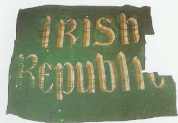‘A national anthem…is a generally patriotic musical composition that evokes and eulogizes the history, traditions and struggles of its people, recognized either by a nation’s government as the official national song, or by convention through use by the people.’ (Wikipedia)
Tens of thousands of Irish citizens regularly sing the Irish national anthem in sports stadia both home and abroad or at other cultural events or meetings, but it is likely that few know the origins of ‘The Soldier’s Song’, or to give it its Irish language title ‘Amhrán na bhFiann’, and probably fewer still understand how or why it became the choice as the national anthem after partial ‘independence’ in 1922. Many people appear to labour under the misapprehension that it was foisted on the nation by the Fianna Fáil party after that party’s establishment in 1926, and some probably have misgivings because of that canard.
‘The Soldier’s Song’ was composed by Peadar Kearney in 1907, with the air by Kearney and Patrick Heaney. Its Irish language translation by Liam O’Rinn was first published in 1923. ‘The Soldier’s Song’ was used as one of many marching songs by the Irish Volunteers, founded in 1913, when on manoeuvres, and while popular for that purpose had no greater significance than some of the more established airs. The clue to what made it stand out, and led to it becoming the national anthem, is provided in Thomas M. Coffey’s great account of the 1916 revolution, centred mainly in and around the GPO during that momentous week, from Monday April 24th to Sunday April 30th.
Coffey’s research for his book involved speaking, fifty years later in 1966, to survivors of the revolutionary forces, mainly of the GPO HQ garrison, and on meticulous research. Writing about the evening of April 26th in the GPO in which the garrison was in holding pattern without the opportunity to engage directly with the enemy, unsure of what was to come, under bombardment and raking fire from a distance, Coffey describes the scene thus:
‘There was a restless stirring, and even in the dim light the haggard, worried expressions showed on the tired faces. Connolly got up from his cot and made the rounds, comforting, exhorting, sometimes scolding, but even by moving among the men at this hour he showed his own concern about their dwindling spirits. Everyone had abandoned by this time the myth of possible victory. There was nothing left for these exhausted and frightened men to think about but the imminent assault against them and, for the survivors of the battle, the dire consequences of defeat.
Connolly looked into their faces, one after another. Then suddenly, without warning, he broke into a bellowing chorus of one of their favorite marching songs, a song that would one day become the Irish national anthem – “The Soldiers Song”.
We’ll sing a song, a soldier’s song,
With cheering, rousing chorus,
As round our blazing fires we throng,
The starry heavens o’er us.
Impatient for the coming fight,
And as we wait the morning’s light,
Here in the silence of the night
We’ll chant a soldier’s song.
The men listened to him dumbfounded at first. Then a few smiles began to appear and a few more voices began to rise until, within a minute or two, the main floor of the building was filled with the song:
Soldiers are we, whose lives are pledged to Ireland;
Some have come from a land beyond the wave;
Sworn to be free, no more our ancient sireland
Shall shelter the despot or the slave.
Tonight we man the bearna baoghail
In Erin’s cause, come woe or weal;
‘Mid Cannon’s roar and rifle’s peal
We’ll chant a soldier’s song.
(Page 153, ‘Agony at Easter’ by Thomas M. Coffey)
So there it is – a national anthem forged in the white heat of revolution, used by Connolly to rouse the troops under his command, and never forgotten by them because of that. Its popularity grew after the revolution had been put down, at least the first phase of it, first in the ‘University of Revolution’ as Frongoch prison camp in Wales became known, having housed prisoners taken by the British after the surrender, and growing again in popularity during the War of Independence.
Unlike most other national anthems which are composed after the fact, ‘The Soldier’s Song’/’Amhrán na bhFiann’ achieved its status and significance because of the symbolic part the song played for the revolutionaries inside the GPO at their moment of need, spurring them on in the struggle and enabling them to achieve an important objective in a task made hopeless in its greater ambition by the treacherous countermanding order of Eoin MacNeill. That lesser objective was to hold out for a week so as to establish the basis that the leaders believed would give them negotiating rights.
There is only one explanation that can readily explain the obscuring of the revolutionary significance of our national anthem from the people ever since it had grudgingly become the de facto anthem in 1926 and that is the desire of the counter-revolutionaries who have ruled Ireland since partial ‘independence’ to distance themselves and the people from the true nature of both the revolution and the Irish Republic that it was intended to create. Why else blank out a compelling story and through that turning our national anthem into being relatively meaningless and disconnected from its source in the modern Ireland that they have created through distorting and manipulating and censoring the foundational narrative of 1916?
So, spread the story to the citizens, allow ‘The Soldier’s Song’-‘Amhrán na bhFiann’ to evoke the image of men and women in a GPO under fire determined to create a revolution. Our national anthem is not a Free State song – it is the song of the Irish Republic. Sing it with pride. Side with the revolutionaries.

